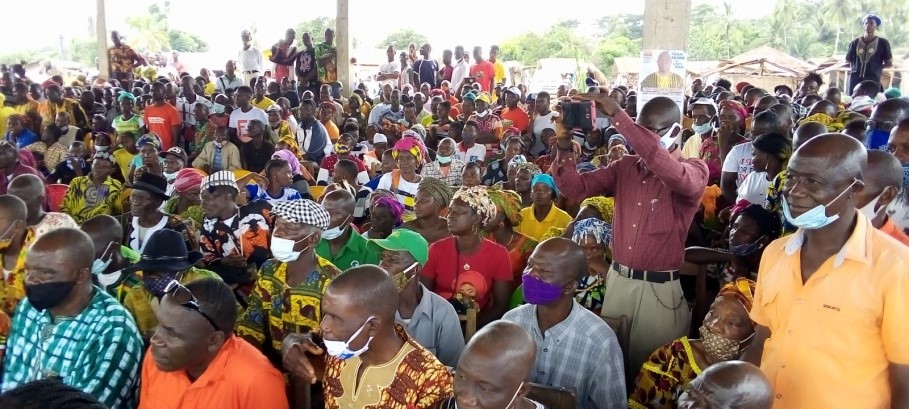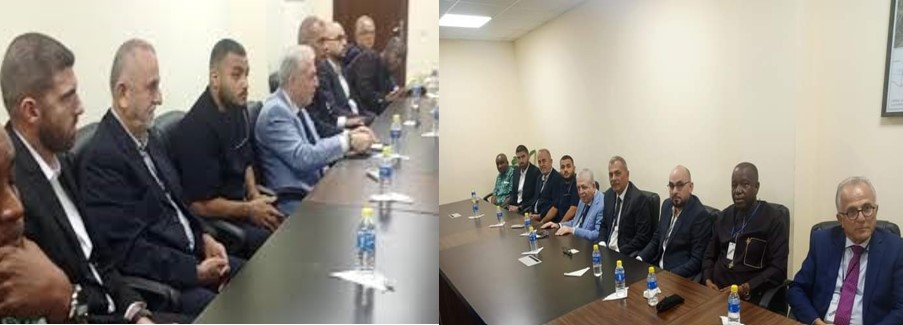By Thomas Domah, Nimba County
IPNEWS: Following a one-day conference held in Sanniquellie, Nimba County on the Mineral Development Agreement from ArcelorMittal, the people of Nimba are calling on the government not to give additional years to the company due to lack of development in its operational areas.
A local group, Nimba Kwado, has been mounting pressure on lawmakers and the Government of Liberia not to grant nine additional years being requested by the mining company.
Dubbed One Nimba conference, the gathering brought together Nimbaians, including District#3 Representative Joseph Nyan Somwarbi, who was seen backing the company, Representative Prince O.S.Tokpah, who later left the meeting, women and youth groups from nine administrative districts of the county, among others.
Speaking to reporters over the weekend during the conference in Sanniquellie, they said the additional nine years being requested should not be granted until ArcelorMittal provides job opportunities for Nimbaians, including housing and improved health facilities, schools, roads and better living conditions in affected communities.
ArcelorMittal Liberia, a subsidiary of the world’s steel giant Mittal Steel, already has a 25-year agreement with the Government of Liberia, which took effect in 2006. But the company has signed an US$800 million Mineral Development Agreement with the Government of Liberia, pending ratification by the 54th Legislature.
The president of Nimba Kwado, Mr.Isaac Dahn, insists that until management can fulfill its promises in Yekepa and other parts of Nimba, the government should not grant it additional years.
Mr. Dahn names some of the activities in the agreement that the company has not been able to implement such as the re-location of G.W. Harley Hospital, the oldest government hospital in Sanniquellie, and renovation of Zolowee Public School, among others.
During the conference, former Senator Saye Taylor Dolo, who first expressed disappointment and frustration in ArcelorMittal’s operations in Nimba, later called on his kinsmen to have a round table with the company to move ahead but urged them to remain peaceful.
Mr. Dolo’s statement followed closed doors meeting with disenchanted citizens during the conference.
Resolution from the One Nimba Conference is expected to be presented to President George Manneh Weah.
Meanwhile, chiefs and elders of Nimba are calling on President Weah to visit the county in order to have a closed-door meeting with them to address their concerns about the current Mineral Development Agreement with ArcelorMittal.
It may be recalled, a new research by a young Liberian scientist and researcher Eddie Miaway Farngalo, details horrible accounts on the human causality citizens of Nimba County and its surrounding are to suffer if the government of Liberia allows an extension of the concession agreement between it and Arcelor Mittal Liberia.
The report details the usage and impacts of Lead, Mercury and Arsenic on human/public health by ArcelorMittal Liberia
Amidst the many lapses in executing its (AML) Cooperate Social responsibilities under the MDA comes contamination of water sources with heavy metals (Lead, Arsenic, and Mercury) in communities within concession areas.
A cross-sectional study conducted between July and September 2014, during which water samples (1 bottle from each community) were collected from communities within the concession area and were analysed for heavy metals at the Nuclear Chemistry and Environmental Research Centre, Ghana Atomic Energy Commission in Accra for heavy metals revealed that communities/towns highly affected are Gbapa with Arsenic level of 0.08mg/l and Mercury level of 0.04mg/l; Yekepa with Arsenic level of 0.016mg/l and Zolowee with Arsenic and Mercury levels at 0.0805mg/l and 0.04mg/l respectively in surface waters. For ground waters, Liabala reported Lead level of 0.064mg/l, Zolowee Arsenic level of 0.0065mg/l and Mercury level of 0.0285mg/l respectively.
Comparing/matching these results gathered from the mining concession with W.H.O permissible levels of 0.001mg/l for Arsenic and Mercury and 0.01mg/l for lead showed that those water sources are highly polluted with three (3) heavy metals (Lead, Mercury and Arsenic).
Notably, the above WHO permissible level of chemicals detected during rainy season when the water table was high, shows how toxic/concentrated it will be for human use/consumption during dry season when the water table will be very low.
Numbers displayed above have lesser meaning to people/readers if consequences of it long time human exposure/usage is not exposed. Therefore, below are adverse effects associated with the three heavy metals that were detected at higher level during the research.
Impacts of Lead, Mercury and Arsenic on human/public health
Lead in water
Long time exposure to lead can cause cancer, damage nervous system in children, brain disorders, autoimmunity (the immune system attacking itself), kidneys problems, miscarriages, reduced fertility in men and the circulatory system (Momodu and Anyakora 2010 and Ofosu-Asiedu et al., 2013).
Mercury in water
Mental disturbance, speech impairment, hearing loss and difficulties in movements are health problems that may arise from mercury toxicity (Momodu and Anyakora,2010). In addition, tremor, irritability, learning disabilities, reduced cognitive functions, immune suppression, nervousness, memory loss, excessive shyness, lack of sleep, muscle weakness, headaches, and hallucinations (false visions) are other health effects associated with mecury ingestion (WHO,2003, ATSDR,2014; Park and Zheng,2012; Ray et al.,2014; Homes et al., 2009).
Arsenic in water
Arsenic is the main source for so many public health problems in some parts of the world. Its consumption in water is related to the development of cancer at several areas of the body (skin, bladder, and lungs), developmental effects, cardiovascular disease, neurotoxicity and diabetes (WHO, 2011, FAO/WHO, 2011a; FAO/WHO, 2011b). Furthermore, arsenic had been considered one of the most common heavy metals that pose health threat to human lives.
Now that human exposure to heavy metals identified in Yekepa mining concession have been known as major sources for chronic illnesses as well as social conditions/problems that individuals suffered/ are suffering from, health of the public is compromised or at higher risk.
Especially for permanent residents who depend on surface and ground water sources for living (bathing, cooking, washing, fishing etc.).
During the research period, as I walked on the streets of Yekepa, I saw young and elderly people bathing, washing clothes and fetching water for homes from the re-developed stream that originated from the old mines.
The colour of the water is brown and at some point red-showing snapshot/face pollution in the sights of passer-by without chemical analysis.
Moreover, I saw AML staff bathing, washing and cooking with mineral water bottles (Aqua life) and even I did use it as well for those purposes.
Sadly, ordinary residents (not employees) have no different safe water sources they were drinking from at the point the research was conducted besides those very water sources that were sampled for testing and even till date.
Possible issues of public health concern raised from polluted water detected are:
There are lot more unanswered questions about why things happened that way. But the public health dangers of our citizens continue to be our greatest concerns as public health specialist.
Especially, when research results and recommendations were shared with company and authorities responsible for public health protection but landed on deaf ears (3 years now).
Based on the results from the study, inhabitants are prone to suffer from health conditions that are associated with heavy metals identified during the research unconsciously due to ignorance, weak regulation on the part of public protection agencies, withholding of research results that might have been conducted before AML begun operations from the general public.
The saddest part is that communities who depend on these water sources for living are unwillingly contracting diseases that are less likely reversible with suffering and death being the final destinations for affected people.
Youths who get exposed to those heavy metals overtime lives’ expectancies are most likely going to be shortened or will suffer irreversible disabilities that may undermine their social lives as well.
Let me clearly state here that due to the nature of the study and history of previous mining in the Yekepa concession, it cannot be certain that AML is wholly responsible for water pollution detected within concession areas operated by them till date. On the other hand, AML and other protection agencies cannot be fully extracted from whatsoever current/future public health ailments suffered by citizens within the concession areas.
To prevent further public health damages, I recommend that: the county authorities especially, representative of the district make the provision of safe drinking water a priority by using some of the social development fund while lobbying with AML for more funds that will adequately provide pipe-borne water throughout the concession areas; ArcelorMittal must conduct a detail study on the impacts of their operation in all the communities within the concession on both surface and underground water sources quality including tubers, vegetable, soil, fish etc. since those chemicals are preferably hosted by those food stuffs.
In addition, the Company should also prepare an action plan to track the possibility of ingesting heavy metals by affected communities, monitor and evaluate the results over a period. On the part of the County Health Team (CHT) representing the Ministry of Health, its main focus must be driven towards preventions rather than curative since diseases or conditions caused by those metals accumulate over time.
Finally, Government through the Environmental Protection Agencies and Lands and Mines must decentralize their activities targeting concession areas rather than deploying few and often inexperienced and/or people who are less knowledgeable of the health implications associated with chemicals normally used in minerals extraction around country.
On top of all, those individuals must be people who cannot be manipulated by cash or kinds against the public’s health and what it means for it to be compromised. (Courtesy of New Dawn)







